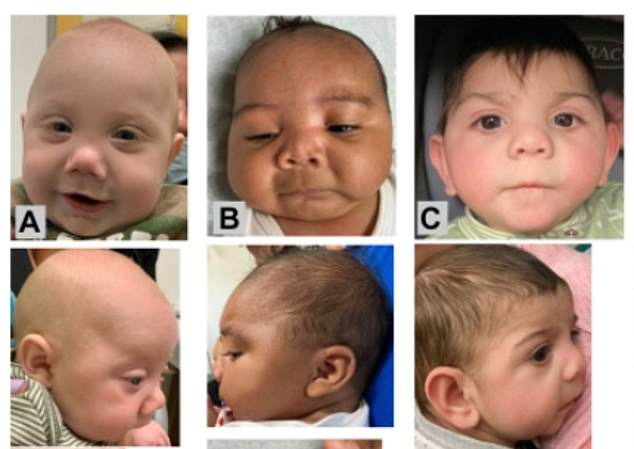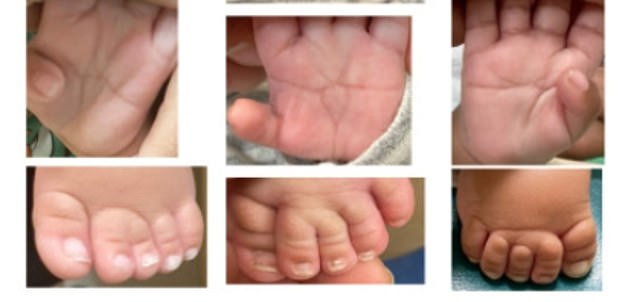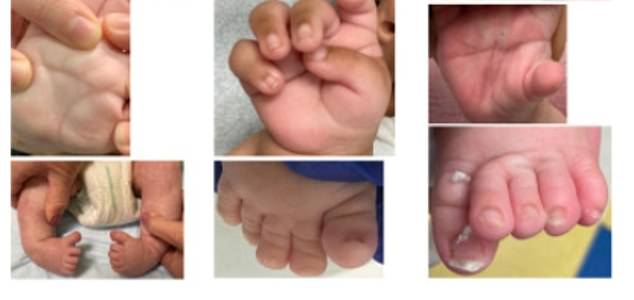Dozens of babies diagnosed with new condition linked to fentanyl that causes deformed heads, conjoined toes and clubbed fingers
Dozens more babies have been born in the US with a terrifying new condition linked to fentanyl abuse during pregnancy.
The condition, known as fetal fentanyl syndrome, causes several physical and brain abnormalities, including fused fingers and toes and deformed heads.
Dr. Miguel Del Campo of Rady Children’s Hospital in San Diego has seen 20 babies with the condition and fears the problem is much more widespread and going undetected.
The syndrome was only discovered last fall and there are no national or regional data on its prevalence.
In addition to underdeveloped jaws, some babies also showed cleft palates
Dr. Del Campo was inspired by that research, which was published by doctors from Vanderbilt University, the University of Nebraska Medical Center and Nemours Children’s Hospital in Delaware.
He said, “After reading the paper and thinking about it, I realized I may have been exposed to fentanyl.”
Fentanyl is thought to damage the baby’s ability to make cholesterol in the womb, a substance essential for brain development.
Babies with the syndrome often have a cleft palate, rocker bottom feet – so called because the arched feet resemble the legs of a rocking chair – a turned-up nose, drooping eyelids, an undersized lower jaw, and webbed toes.
Dr. Del Campo said NBC News: ‘I have identified 20 patients with these characteristics.
“I’m afraid this is not uncommon and that children are not being recognized,” Dr. Del Campo added.
Fears that the number of cases is undercounted are growing as fentanyl becomes the leading cause of overdose deaths. The rate of fatal overdoses linked to fentanyl is at an all-time high, tripling from 2016 to 2021, from 5.7 per 100,000 people in 2016 to 21.6 in 2021.
Fentanyl is increasingly being used to lace other substances and addict users, who are often unaware they are using fentanyl.

The babies affected by maternal fentanyl use generally had smaller heads and underdeveloped jawbones
More evidence is needed to conclusively establish that fentanyl is the cause of these birth defects. This is not yet an established scientific fact.
For example, just two years ago the National Institutes of Health stated that “based on the studies reviewed, fentanyl exposure is not expected to increase the risk of birth defects above the background risk.”
Fentanyl passes through the placentathe organ that develops during pregnancy and supplies the fetus with oxygen and nutrients.
Researchers identified an earlier study in which ‘fentanyl was found in fetal brain tissue. From this, they concluded that fentanyl is rapidly transferred to the fetus in early pregnancy and that the drug remains in fetal tissue for some time.’
But the NIH has said that “studies have not found a specific pattern of birth defects caused by opioids” and cannot conclude that fentanyl causes these effects.

Some babies also had wider thumbs than normal, and a single horizontal crease on their palms instead of the normal two.

In several babies the toes were fused together and the feet were rounded with a ‘rocking bottom’
Last year, Delaware pediatricians and researchers identified 10 babies with the defects in their state, as well as in California, Boston and Rhode Island, who are believed to be suffering from fetal fentanyl syndrome. The study was separate from the one led by Vanderbilt scientists.
There was no established link between cholesterol production and these symptoms until scientists at Vanderbilt began investigating possible causes.
They analyzed the similarities between fetal fentanyl syndrome and a genetic condition called Smith-Lemli-Opitz syndrome (SLOS), which is caused when a person has two genes that interfere with the body’s ability to make cholesterol.
They found that when a fetus has only one of these genes, he or she is much more susceptible to the birth defects associated with fentanyl exposure in the womb.
Ned Porter, a research professor of chemistry at Vanderbilt University, said: ‘Fentanyl not only disrupts cholesterol synthesis, but also leads to the accumulation of the same highly toxic sterols in cells that are found in SLOS patients.
‘It appears that the presence of this substance during fetal development plays a major role in these syndromes.’
